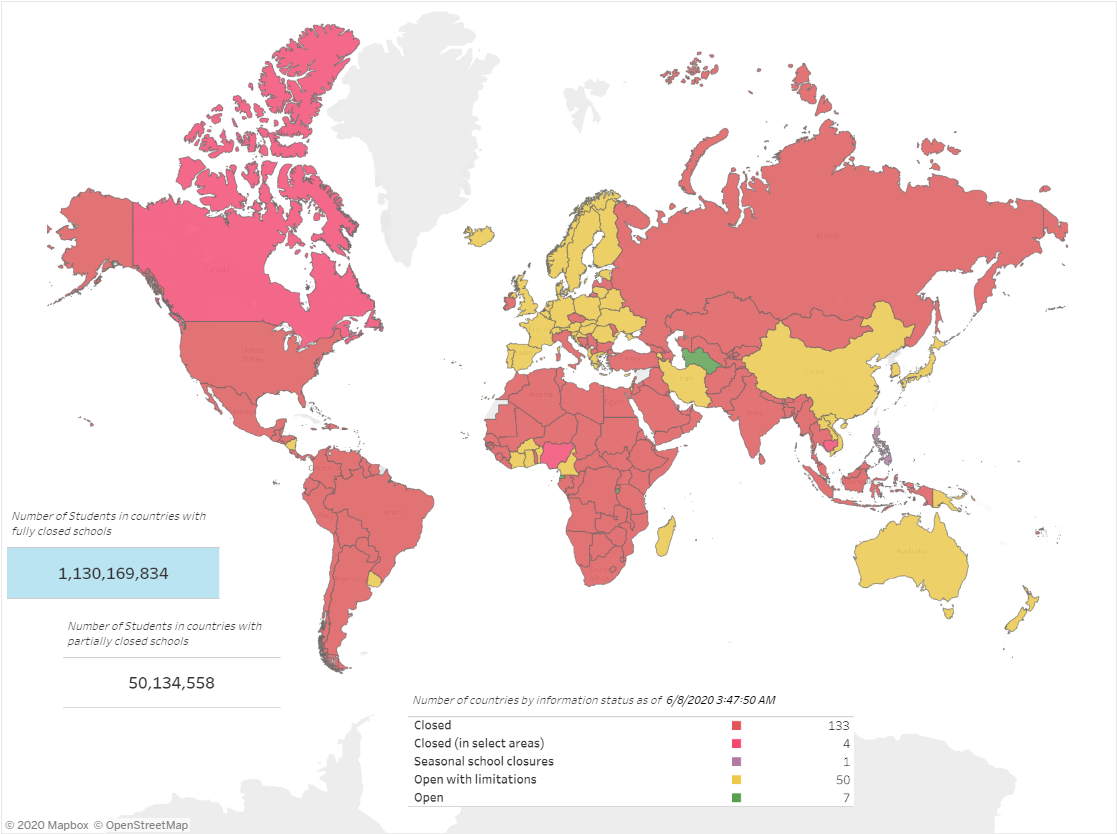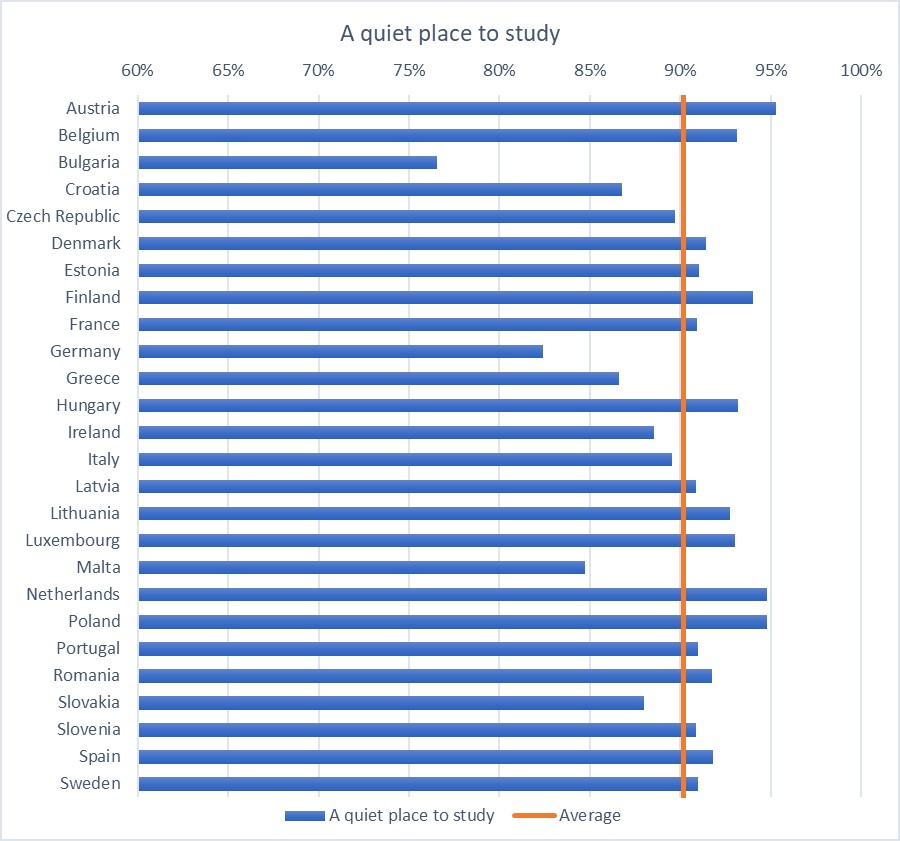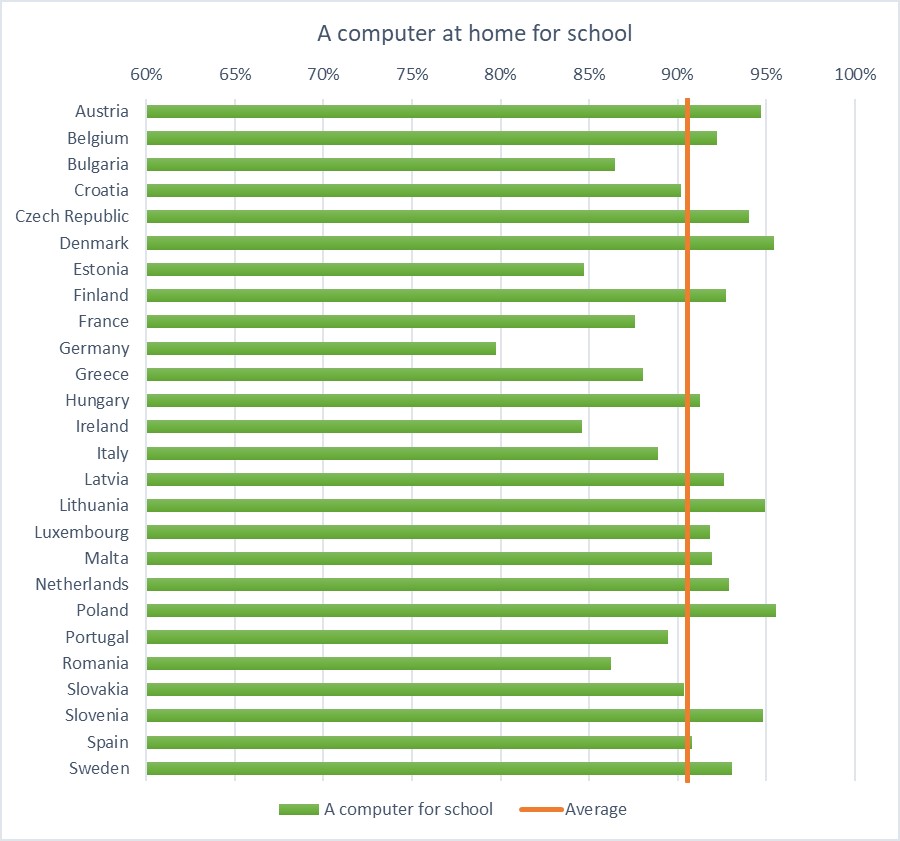Education during COVID-19; moving towards e-learning
The global school closures over the last few months, as an attempt to contain the contagion, affected more than a billion children worldwide. Luckily, education did not grind to a halt, but it transformed and moved online. However, this also highlighted socio-economic differences as internet access and the need of suitable technology.
Introduction
In order to contain the contagion, many countries have implemented restrictive measures to reduce gathering and formations of crowds. Schools are also affected and had to reduce their classes or close entirely. One can only imagine the impact when, at the peak of the crisis, almost 1.6 billion children in 195 countries worldwide could not use their classrooms. If school closures are extended for too long, there is a significant potential for loss of educational opportunities, but also a potential loss of human capital and diminished economic opportunities in the long-term. Fortunately, the closing of schools did not entirely stop education, although it changed it. To reduce the impact of closures, schools have been looking for alternative ways to provide access to education. On the side of home schooling, students and children are currently, wherever possible, remotely educated all over the world, using technology such as online courses, video classes, and electronic textbooks.
Impact on Education
The total closure of schools in some countries is impacting over 60% of the student population. Even in those countries that have implemented only localised closures, it still impacted millions of students. In order to support continuity in education the European Commission is supporting the Member States by listing a range of online platforms and EU-funded projects. The Commission will also be reviewing the Digital Education Action Plan in 2020, which is intended to support the development of online learning at different levels of education across Europe. Several organisations used data to visualise the impact of COVID-19 related measures on education.
UNESCO – COVID-19 Impact on Education
The United Nations Educational, Scientific and Cultural Organisation (UNESCO) is a United Nations agency that aims to build peace, fight poverty, and invest in sustainable development and intercultural dialogue through education, science, culture, communication, and information. UNESCO monitors the policy responses that are deployed to combat COVID-19 and their impact, such as school closures. They created an interactive dashboard, shown in figure 1.

Figure 1: Screenshot of interactive dashboard created by UNESCO.
The dashboard visualises, since February 2020, the evolution over time in terms of number of affected learners, affected learners as percentage of the total, and number of nationwide school closures. The students represented by the data are learners enrolled in pre-primary, primary, lower-secondary, and upper-secondary levels of education (International Standard Classification of Education levels 0 to 3), as well as at tertiary education levels (levels 5 to 8). The data is openly available and is updated on a weekly basis.
World Bank – Education and COVID-19
The World Bank aims at reducing poverty, increasing shared prosperity, and promoting sustainable development. They created, similar to UNESCO, an interactive dashboard to visualise the impact of COVID-19 on education worldwide, shown in figure 2.

Figure 2: Screenshot of interactive dashboard created by World Bank.
The dashboard displays for every country the status of the schools and the number of affected students in the pre-primary, primary, secondary, and tertiary level of education. The dashboard is based on openly available data from EduAnalytics and updated regularly. The World Bank is providing ongoing support to systemic education reform to provide the optimal learning environment for students when they will return to school.
Transition to Digital Education
A survey conducted by UNESCO concluded that most education systems, of the 61 questioned countries, implemented measures related to distance learning. Schools, teachers, families, and learners have taken on e-learning at large, where teaching is undertaken remotely and on digital platforms. There are some exceptions, for example Sweden did not close their primary schools, and in e.g. Belgium and Norway a few school facilities remained partially open for children whose parents are working in essential sectors. Additionally, governments all over the world utilise technologies to provide remote learning opportunities for students while schools are closed, which are supported by the World Bank. A catalogue listing the measures taken per country is provided by the World Bank.
The use of digital content in education worldwide was relatively uncommon before the crisis started. Only 20% of countries had digital learning resources in teaching, but only in some schools. A mere 10 percent of countries had more robust digital learning capabilities offering some of the educational materials available outside of school. According to the World Bank, no country has a universal digital curriculum for teaching and learning. These numbers paint a picture of the efforts that governments and schools had to take to rapidly move to distance learning to ensure continuity of learning.
To appropriately switch to online learning, three requirements need to be fulfilled: access to the internet, the right technology, and the skills to use the technology. To provide a better understanding of how European learners are impacted by school closures and can access online education, an interactive map was created by the European Data Portal, shown in figure 3. The map is created by combining data from a survey conducted by the Organisation for Economic Co-operation and Development (OECD) in 2015 and re-using the data behind the aforementioned dashboard created by the World Bank. For the European countries, the restrictive measures on schools, the number of students affected, and the access to internet and technology are displayed. As can be seen from the high percentages displayed in figure 3, the digital infrastructure in Europe is rather advanced, since most schools and households have access to the internet.

Figure 3: Screenshot of interactive map created by the European Data Portal, source: OECD, World Bank.
The digital infrastructure is not as advanced everywhere as it is in Europe. Global estimates suggest that 826 million students have no access to a computer in the household, 706 million lack internet access at home and another 56 million lack coverage by mobile 3G or 4G network. Families without access to the internet experience a major disadvantage during the crisis, and this often happens in already disadvantaged homes. For example, according to estimates from the International Telecommunication Union (ITU), 82.2% of households in Africa lack internet access in their homes. Moreover, previous health emergencies, most recently the Ebola outbreak, showed that the impact on education is likely to be most devastating in countries where there are already low learning outcomes and high dropout rates.
Besides having access to the internet, it is also important to have a quiet place to study and a device to work on. Families with multiple children that need online education may not have a dedicated device per child, making it difficult to follow all classes. According to a report published by the OECD, based on data from the Programme for International Student Assessment (PISA) among 15-year-olds, there are, again, large differences between socio-economic groups. In many European countries, over 95% of students report that they have a computer to use for working at home. About 91% reports that the have access to a quiet place to study. However, in Indonesia for example only 34% have a computer, and only 70% have access to a quiet place to study.
To provide an overview on these topics in Europe, figure 4 and figure 5 are created based on the data provided by the OECD. Figure 4 and figure 5 show what percentage of the 15-year-old surveyed students have a computer to work at home and a quiet place to study at home, respectively.

Figure 4: Percentage of 15-year-old students in the EU hat reported to have a computer at home for school, source: OECD.

Figure 5: Percentage of 15-year-old students in the EU that reported to have a quiet place to study, source: OECD.
The other part of the equation is how educational institutions are equipped for online learning, and how well teachers are prepared for, and engaged in online teaching. Teachers need to quickly adjust their teaching methods and learning expectations. They need to find a way to cover as much of the curriculum as possible using a fundamental different way of teaching. On average across OECD countries, 65% of the 15-year-olds are enrolled in schools whose school principal stated in a survey that teachers have the necessary technical and pedagogical skills to integrate digital devices in instruction. Teachers are the key to successful implementation of distance learning. Almost 50% of the UNESCO surveyed education systems, across all income levels, are providing additional teacher trainings to properly prepare for distance teaching.
Changes in the Future
Nowadays, parents, students and teachers across Europe are adapting to the ‘new normal’ with education from a distance. As schools start reopening again, there are two time horizons against which changes can be observed. In the short-term, schools need to guarantee that proper hygiene and social distancing measures are undertaken, they need to create trust among parents to allow their children back in schools, and they need to consider possible learning losses and how to compensate for those. In the long term, possible permanent changes to the educational systems could be observed. Not only does this require adapting to the use of technology but – with growing volumes of data being created about the students’ behaviour and performance – it also forces schools to further consider the privacy and protection of the pupils’ personal data.
Although the school closures initially caused disruption, over time they also prompted examples of educational innovation. There are signs suggesting that the crisis can have a lasting impact on the trajectory of learning innovation and digitisation. The World Economic Forum argues that the possible changes consist of three aspects:
- The crisis could accelerate innovation within education. For those who do have access to the internet and the necessary technology, there is evidence that learning online can be more effective. With this insight and the experience gained during the crisis, new digital learning possibilities could be implemented by educational institution to stimulate productivity of the lessons. Potential innovations include educational applications, platforms and resources. All aiming to help parents, teachers, schools and school administrators to facilitate student learning, social care, and interactions during periods of school closure. For examples of already available online resources, see the list created by UNESCO with all national learning platforms and tools.
- Public-private educational partnerships could grow in importance. The past decade showed increased interest from private companies in education. The pandemic could pave the way for large-scale, cross-industry cooperation around a common educational goal.
- Given the digital divide, new shifts in education approaches could widen inequality. The quality of education depends on access to internet, the right technology, and the required skills to use it. As already mentioned, this differs heavily per country. The digital divide could worsen if the effectiveness of education is directly linked to access to the latest technologies.
It is too early to judge whether a new hybrid educational system will emerge with both face-to-face and online classes, or the short-term preparation to online learning will result in poor performance and suggest going back to traditional methods. As the situation further progresses and more data on the topic is gathered, extensive analysis of the larger-scale impact of the pandemic on education can be conducted by experts in the field.
Looking for more open data related news? Visit the EDP news archive and follow us on Twitter, Facebook or LinkedIn.
